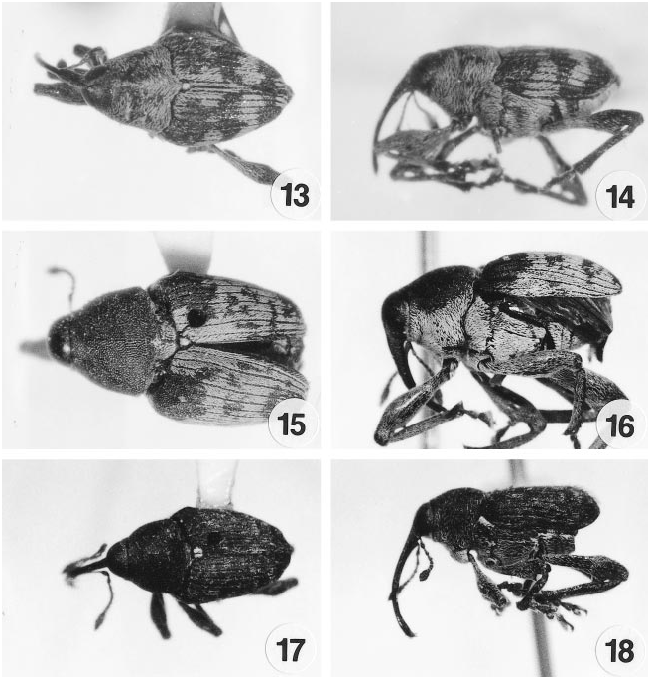Curculio latusrostris Pelsue and Zhang
|
publication ID |
https://doi.org/10.1649/0010-065x(2000)054[0467:arotcf]2.0.co;2 |
|
DOI |
https://doi.org/10.5281/zenodo.15700364 |
|
persistent identifier |
https://treatment.plazi.org/id/8C170A27-B60E-9473-FEB8-A55CFD23FCF8 |
|
treatment provided by |
Carolina |
|
scientific name |
Curculio latusrostris Pelsue and Zhang |
| status |
sp. nov. |
Curculio latusrostris Pelsue and Zhang View in CoL , New Species
Figs. 15–16 View Figs , 54–56 View Figs
HOLOTYPE. China. Ruili : male [China/ Yunnan /Ruili/ 05 July 1959 /IZAS] ( IZAS)
PARATYPE. (8) China. (1) male [China/ Yunnan / Xishuangbanna / 30 August 1958 /850 M/ L.Zhang]( FWPC) (2)Female [ China / Guangxi / Longrui / 16 October 1984 / S. Song] ( FWPC) ( 5) [ China] ( BMNH)
Recognition Characters. Mediumsized, oval, robust; derm piceous; rostrum, 0.48 as long as body; frons moderately broad, 0.25 as wide as head across eyes; interocular fovea present; pronotum with basal arrowshaped, luteous macula; scutellum small, subimpressed; elytra with basal, scutate, luteous macula, and broad luteous macula in apical half, remainder of scales fuscous.
Description. Male: Length: 3.8–5.8 mm (mean = 4.8). Width: 1.9–3.3 mm (mean = 2.6). Head: Moderately convex, broad; punctures small, numerous, clothed with short, narrow, white scales; ventral macula beneath eyes, of dense clavate, luteous scales; eyes large, finely faceted, partly covered by ocular lobes of pronotum; frons moderately broad, 0.25 as wide as head across eyes; sparsely clothed with narrow, elongate, white scales; interocular fovea scutate, deep. Rostrum: Length: 1.8–2.8 mm (mean = 2.3); 0.48 as long as body; piceous basally, testaceous apically; thickly cylindrical; laterally margins subimpressed, with larger punctures basally appearing squared; dorsally thick at base to antennal insertion, then abruptly tapering to narrowing subparallel apex; evenly arced; median dorsal carina from interocular fovea to base of rostrum with mediumsized oval punctures to antennal insertion; vestiture of short, narrow, white scales; scrobe ventral; scape inserted in apical half. Antennae: Length: Scape 1.2–1.4 mm (mean = 1.3); Funiculus: segment one 0.4 mm, two 0.3 mm, three 0.2 mm, four 0.15 mm, five 0.15 mm, six 0.1 mm, seven 0.15 mm, club 0.6 mm; funicle 1.9 mm; scape 0.69 as long as funicle, twice as long as club; derm fuscous; vestiture of narrow, elongate, white scales, with longer erect setalike scales toward apex of each segment; club elongate, oval, compact, acuminate, segments 1–3 long 4 short, vestiture of velvety pile, with few erect setae, testaceous; club longer than funicular segments 4–7. Thorax: Length: 1.0– 1.7 mm (mean = 1.35). Width: 1.4–2.5 mm (mean = 1.95). 0.7 as long as broad; margins of disc angled toward constriction, slightly rounded; disc flat in lateral view, with indication of median carina; punctures small, deep, close together with narrow, elongate, white to luteous, scales, basally with broad, arrowshaped, macula of luteous scales; ventrolaterally densely clothed with clavate, luteous scales; mesosternal intercoxal process prominent, densely clothed with narrow, elongate, white scales; scutellum small, subimpressed, longer than broad, with luteous, scales; mesepimeron, mesepisternum and metepisternum clothed with elongate, clavate, luteous scales; procoxae clothed with luteous scales anteriorly, and white scales posteriorly. Elytra: Length: 2.2–3.5 mm (mean = 2.85); Striae narrow, deep, punctate, lacking scales; humeri roundly angulate to pronotum; disc flat, with scutellar declivity; intervals broad, flat, clothed with narrow, elongate, white scales, with basal scutate macula of luteous scales, with a broad fascia of clavate, luteous scales in apical half; crosshatched setae not prominent. Legs —Length of hind femur 1.8–2.9 mm (mean = 2.3), tooth mediumsized, larger than mesofemoral tooth, wedge shaped; profemoral tooth small, mesofemoral tooth mediumsized; hind femur stout basally, lacking proximolateral sulcus; derm fuscous; vestiture of all femora of narrow, elongate, white scales; tibial margins subparallel, almost straight; pro, meso and metauncus large, longer than tarsal claw. Abdomen: Sternite 1 as long as 2 behind coxal cavity, with broad median shallow declivity; sternite 2 longer than 3, ascending to 3; sternites three and 4 combined, as long as 5; sternite 5 with acute lateral projections, apex emarginate with lateral tufts of setalike scales; all sternites evenly clothed with clavate, luteous scales. Pygidium: Large , vertical, scutate, clothed with short, testaceous setalike scales. Genitalia: Median lobe of aedeagus 2.0 mm in length, 0.4 mm in width, sides thick at midpoint, then opening to broad rounded opening, before tapering to long arced blunt apex clothed with long ventral setae: endophallus with fine teeth, thick in lateral view; apodeme 1.7 mm in length ( Figs. 54–55 View Figs ).
Female: Length: 4.7–4.8 mm (mean = 4.75). Width: 2.3–2.5 mm (mean = 2.4). Rostrum: Length: 2.2–2.5 mm (mean = 2.35) dorsal aspect with three carinae from frons to insertion of scape; punctures deep and oval; frons lacking interocular fovea; scape inserted in basal half. Antennae: Length: Scape 0.6–0.7 mm (mean = 0.65). Funiculus: segment one 0.40 mm, two 0.25 mm, three 0.18 mm, four 0.15 mm, five 0.15 mm, six 0.13 mm, seven 0.15 mm, club 0.40 mm; funicle 1.7 mm.; scape 0.39 as long as funicle. Thorax: Length: 1.3–1.4 mm (mean = 1.35). Width: 1.7–1.9 mm (mean = 1.8). Elytra: Length: 2.7–2.9 mm (mean = 2.8). Legs: Hind femur 2.3–2.4 mm (mean = 2.35). Abdomen: All sternites ascending; sternite 5 with rounded apex; all sternites clothed with narrow, elongate, white scales. Pygidium: Concealed. Genitalia: Spermatheca ramus and collum oblique, bifurcated; cornu thickened at base broadly tapering to an apical nipple ( Fig. 56 View Figs ).
Plant Associations. Ficus microcarpa Linnaeus
Distribution. China: Yunnan Province, Ruili, Xishuangbanna; Guangxi Province, Longrui.
Remarks. This species is distinct from all other species in this group based on general appearance and male genitalia.
| IZAS |
Institut Zoologii Akademii Nauk Ukraini - Institute of Zoology of the Academy of Sciences of Ukraine |
No known copyright restrictions apply. See Agosti, D., Egloff, W., 2009. Taxonomic information exchange and copyright: the Plazi approach. BMC Research Notes 2009, 2:53 for further explanation.
|
Kingdom |
|
|
Phylum |
|
|
Class |
|
|
Order |
|
|
Family |
|
|
Genus |


